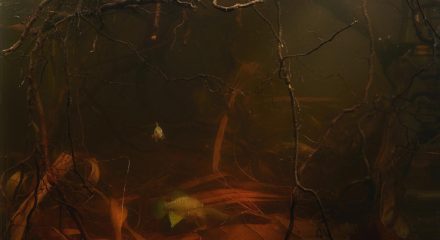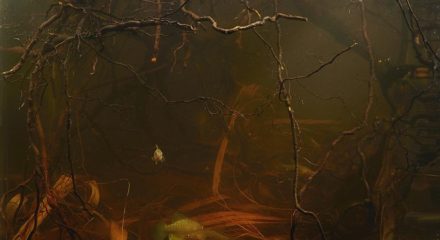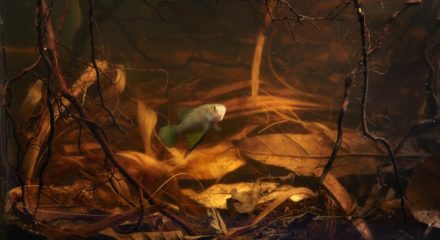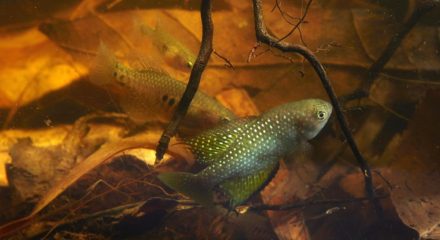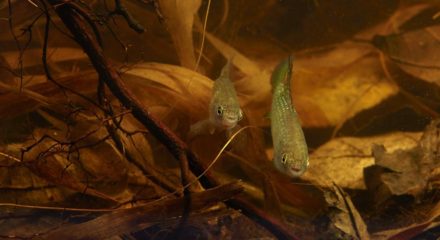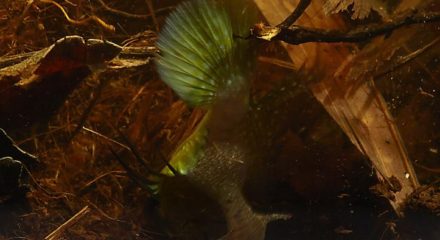Small pool in São Domingo River basin, Brazil
15th place in Biotope Aquarium Design Contest 2016
![]() Russia. Svetlana Kirillova
Russia. Svetlana Kirillova
Aquarium Volume: 20 L
Fish and invertebrates: Hypsolebias mediopapillatus “Pindai”
Plants list: None
Biotope description: In this biotope aquarium there is a small temporary pond for seasonal South American killifish Hypsolebias mediopapillatus “Pindai”. The pond is, in fact, a small hole under the roots of a tree filled with rain water. Here often there is only one species of fish and aquatic plants are completely absent. Nevertheless, the aquarium, created based on similar water body is an interesting object for observation due to a number of its inhabitants. All killifish by way of life are divided into three groups: seasonal live in nature less than a year, during the wet season, when water fills a temporary pools and eggs are preserved in the mud from the last rainy season. There are juveniles that grow quickly and after 1.5 – 2 months begin to multiply, then to die, when the pond dries out again, leaving a new batch of eggs. Transient killi’s eggs depend on the degree of drought. They can wait the dry season in the diapause or no development in the water. And the off-season killi, who live longer than others, and their eggs that do not need drying. Males of different species of killifish usually are very colorful and show interesting rituals of courtship. This applies particularly to the seasonal types, because their whole life cycle in nature lasts few months, and during that time they have to do everything. Put in correct aquarium (small column of water, ambient lighting, a thick layer of soft dark soil), these fish begin to spawn. In the photos you can see how the male Hypsolebias mediopapillatus “Pindai” demonstrates his delightful color. A couple “dive” into the ground in the process of spawning. The video was filmed in 7-8 hours after the shooting, this time the females are tired of courting and hid in the roots and fallen leaves, and the males are mainly competing with each other. The next day spawning resumed.
Fish and invertebrates: Hypsolebias mediopapillatus “Pindai”
Plants list: None
Biotope description: In this biotope aquarium there is a small temporary pond for seasonal South American killifish Hypsolebias mediopapillatus “Pindai”. The pond is, in fact, a small hole under the roots of a tree filled with rain water. Here often there is only one species of fish and aquatic plants are completely absent. Nevertheless, the aquarium, created based on similar water body is an interesting object for observation due to a number of its inhabitants. All killifish by way of life are divided into three groups: seasonal live in nature less than a year, during the wet season, when water fills a temporary pools and eggs are preserved in the mud from the last rainy season. There are juveniles that grow quickly and after 1.5 – 2 months begin to multiply, then to die, when the pond dries out again, leaving a new batch of eggs. Transient killi’s eggs depend on the degree of drought. They can wait the dry season in the diapause or no development in the water. And the off-season killi, who live longer than others, and their eggs that do not need drying. Males of different species of killifish usually are very colorful and show interesting rituals of courtship. This applies particularly to the seasonal types, because their whole life cycle in nature lasts few months, and during that time they have to do everything. Put in correct aquarium (small column of water, ambient lighting, a thick layer of soft dark soil), these fish begin to spawn. In the photos you can see how the male Hypsolebias mediopapillatus “Pindai” demonstrates his delightful color. A couple “dive” into the ground in the process of spawning. The video was filmed in 7-8 hours after the shooting, this time the females are tired of courting and hid in the roots and fallen leaves, and the males are mainly competing with each other. The next day spawning resumed.
Photo Gallery
Comments of the members of the jury of Biotope Aquarium Design Contest 2016

A rare fish in the hobby indeed.

Very good mixture of various decaying plant matter, looking very natural. However, the tank is really small – probably too small for keeping water parameters stable over longer period. But for breeding purpose it should be OK.

Very interesting layout with very natural atmosphere. The strong point is the good appearence very close to the natural enviroment, but the tank could be bigger. I liked so much the leaves and the organic material on the bottom. The fishes are in good shape and probably very happy in there.

